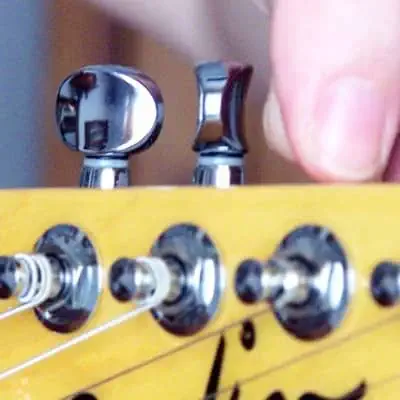
The three most used or main groups of alternate tunings for Guitar are:
- Downtuning
- Open
- Drop
Alternate Tunings for Guitar: Downtuning
The Downtuning are often applied to the guitar, in order to properly handle thick string gauges. Since strings of a certain thickness in standard tuning, would feel too uncomfortable. Especially when performing bends.
This type of tuning, in addition to increasing the playability of high gauge strings, is also often used to obtain thick and forceful Blues-style sounds, or even to obtain heavy sounds for Metal music.
Since the string has less tension, it consequently generates a less bell-shaped sound, or even less defined. There are numerous guitarists who use or have used downtunings, such as Slash, or Stevie Ray Vaughan.
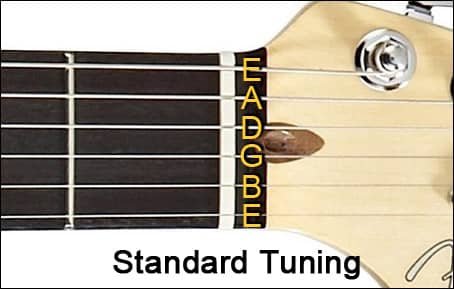
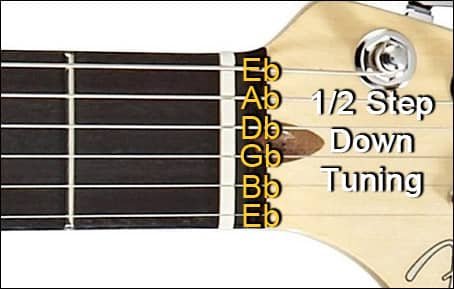
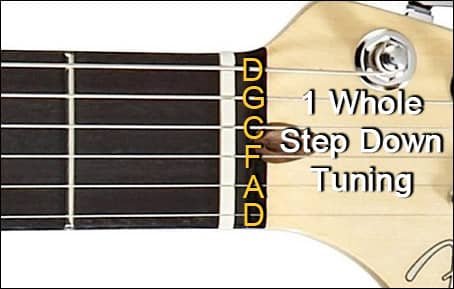
The method of this tuning is very simple. It is only a matter of lowering the standard tuning E – A – D – G – B – E, as necessary to obtain the comfort we are looking for. So this can be done simply depending on our personal taste, and the strings gauge we want to install on the guitar.
But we always have to compensate for the tension of the string, with its gauge.
Consequently, very thick strings will allow a greater lowering, and thinner strings could not be lowered too much, so that they do not lose the minimum and necessary consistency.

As a result, we can lower this tuning, a semitone, a whole tone, a whole tone plus half step, etc…, depending on the factors indicated above. We can easily do this with a chromatic tuner. Since this type of tuner tells us exactly the note that is playing at all times.
Downtuning: Fingerboard Notes Change
In a downtuning, we must take into account that the distribution of all the notes that we can find on the fretboard would obviously change their place, compared to a standard tuning.
For example, if we lower the tuning a semitone (one fret), and place an F barre chord on the first fret, an F would no longer sound, but an E would sound. And if we lower the tuning whole tone, a D♯ would sound.
This seems a bit complicated, but if we mainly use barre chords, and take into account tuning discount, it’s easy to control.


In a guitar solo we would use the same technique. If for example we down the tuning one whole tone of the guitar, you already know that we will have to move the entire structure of the solo, two frets in the direction of the body of the guitar to compensate for the tuning.
Alternate Tunings for Guitar: Open Tuning
These types of tunings are formed, using the appropriate notes to build a chord, when we play the open strings.
For example, the D major chord is made up of three notes: Tonic or first (D), Median or third (F♯), and Dominant or Fifth note of the scale (A).
If we tune the guitar with these three notes we will have an Open D tuning:
- The sixth string goes down to D.
- The fifth and fourth strings are exactly the same as a normal tuning, since they coincide with the notes we need for this tuning.
- The third string goes down to F♯.
- The second goes down to A.
- And the first string goes down to D.
Open D Tuning on Guitar
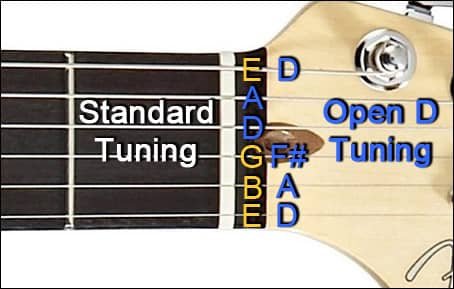
With this type of tuning, we can place a number of different major chords, just placing a barre with the index finger, anywhere in the fretboard.
This would be essential for slide playing. Since we adapt the tuning of the guitar to a bottleneck.
Open G Tuning on Guitar
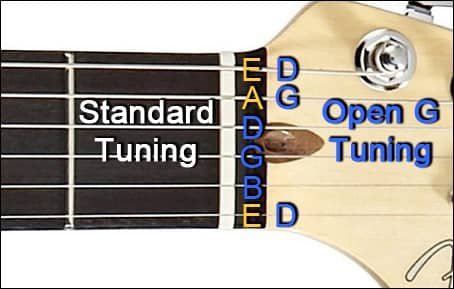
When playing all the Open Strings will give us a G Major chord, and the Tuning Notes would be the following:
- Lower the sixth string to D.
- The fifth string goes down to G.
- The fourth, third and second strings remain in the standard tuning.
- And the first would go down to D.
This is one of the most popular open tunings, used by many guitarists. For example, Mark Knopfler uses an open G tuning on his resophonic guitar to play some of his most iconic songs such as “Telegraph Road”, or “Romeo and Juliet”. Keith Richards also uses this tuning on his famous Telecaster, to play such legendary Rolling Stones songs as “Start Me Up”.
Open C Tuning
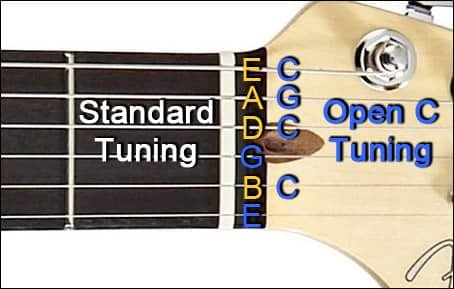
When playing all the Open Strings will give us a C Major chord, and the Tuning Notes would be:
- The sixth string goes down to C.
- The fifth would go down to G.
- The fourth would go down to C.
- For the third string a standard G would remain.
- The second would go up to C. And the first string would be a standard E.
Open E Tuning

Strumming all the Open Strings will give us an E Major chord, and the Tuning Notes would be the following:
- Standard E for the sixth string.
- The fifth string would rise to B.
- The fourth string would rise to E.
- The third string would go up to G♯.
- And the second and first strings would remain as a standard tuning.
This last tuning is one of the easiest to handle, since we have the reference of the notes of the sixth string, in a standard tuning. That is, if we play all the open strings an E chord would sound. If we place a barre with the index finger on the third fret we would have a G chord, and on the fifth fret an A chord.
Open D minor Tunning
Just as we can set up an open tuning with the notes of a major chord, we can also use the notes of a minor chord.

With this tuning we obtain a D minor chord when we play the open strings. These open notes that we must achieve to obtain an Open D Minor Tuning are: D (6th string) – A – D – G – A – D.
Alternate Tunings for Guitar: Drop and Double Drop
Drop tunings are of the most used alternative guitar tunings. This type of tuning consists of lowering 6th String a Whole Tone, compared to another standard tuning.
For example, for a Drop D tuning, we would have to lower only the sixth string to go from E to D, and the rest of the strings would have a standard tuning (image below).
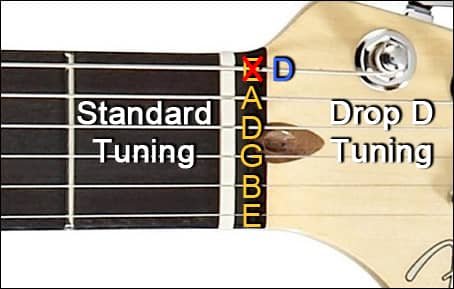
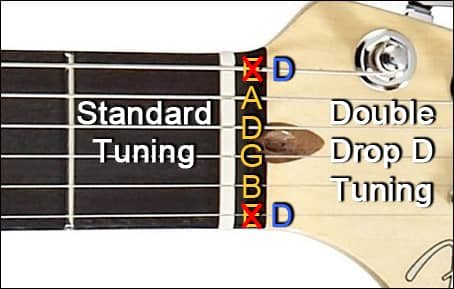
If we want, we can also tune the first string, in the same way as the sixth string. This would be called a Double Drop (image above).
For a Drop C tuning, we would have to lower the sixth string to C. So the rest of the strings would have to be 1 tone lower compared to a standard tuning (image below). To be able to perform this drop, we would need thick strings that support such a low tuning.
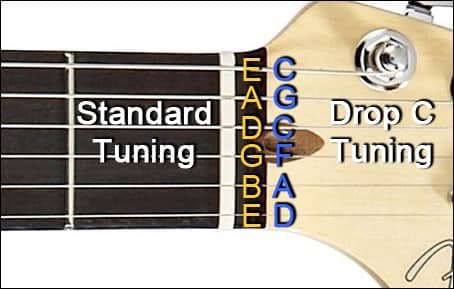
These Drop tunings benefit us when placing power chords with a single finger on the last three strings. Fifth chords are composed of only two notes, the tonic note and the fifth note of the chord in question, with the tonic note repeated on the fourth string.
This type of tuning is very popular, and among the musicians who have used it are the guitarists of Metallica, Tom Morello, or Richie Kotzen.
